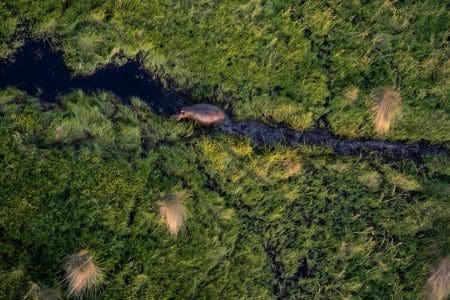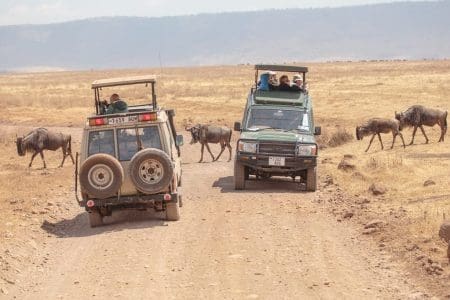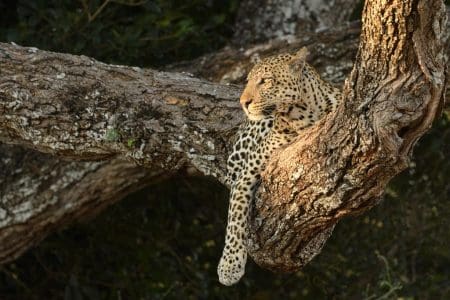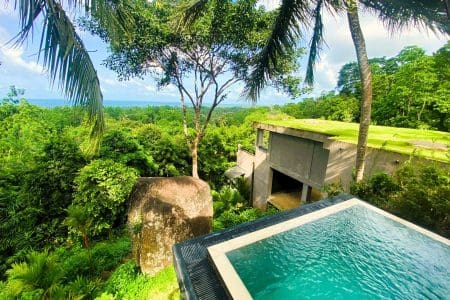in the first of two articles, Roger Hermiston and Eileen Wise take an amazing Botswana safari, staying at three camps run by Great Plains Conservation, commencing at Selinda Camp.
It was half past eight on another luminous morning in the Botswana bush and, to our great excitement, we were on the trail of the elusive leopard – the greatest prize of all, the only one of the ‘Big Five’ animals we had never encountered.
Our expert guide Alex spotted what he was sure were fresh footprints from the night before, so he swung our Toyota Land Cruiser off the road and away we went in pursuit. With its light yellow coat and dark, square, irregular spots, the Southern African leopard is a master of camouflage. But it has a feature that can reveal it to an eagle-eyed spotter, and it was this that our companion Lizzy now identified.
“Look there,” she whispered dramatically, “the tail!” We swivelled to our left and sure enough, there was the flash of the prominent white tip of a tail, often used by a leopardess to guide her cubs through the long grass, but now confirmation that we were, indeed, finally about to come face-to-face with this magnificent creature.
We edged closer, and as the animal moved out of the tall heart-shaped love grass we could see it in all its glory. Alex identified her as a four or five-year-old female, the fur on her back a reddish-orange colour: on the evidence of a swollen belly, she was clearly hungry, on the move and on the hunt.
For the next hour, we tracked her at close quarters, Alex often having to crunch his vehicle through the many scrambling, shrub-like ‘knobbly combretum’ trees (which spring straight back up after being flattened) in order to keep up.
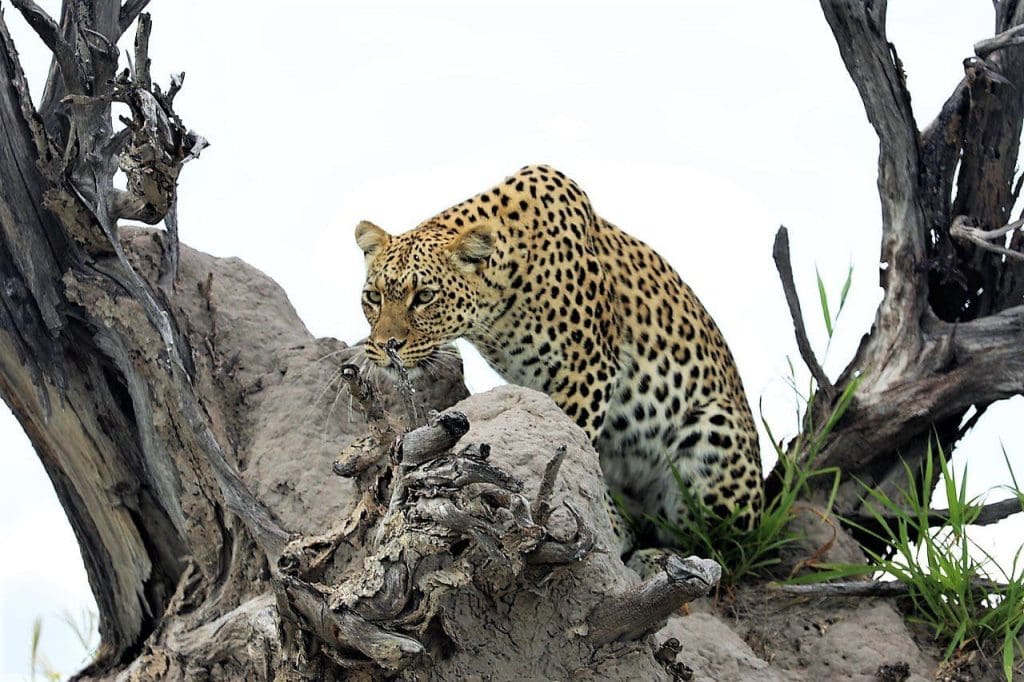
‘Beautiful Lady’, as we called her, seemed unperturbed by our presence. When not moving stealthily through the undergrowth, she would stop and rest in the shade of bush or tree, stretching and then grooming herself meticulously. Once, the sound of a lion’s low growl from far away caused her to sit up more attentively.
Eventually, she led us to a spread-eagled giant fallen tree – the top of which was lain across a termite mound – where she first crawled underneath before soon emerging at the top in full view, casting her gaze disdainfully beyond us to the wide-open spaces. “I’m the Queen of all I survey”, she seemed to be saying, “and this is your final look.” With that, she slipped away, and we began the journey back to our camp, exhilarated and fulfilled.
Botswana Safari – Great Plains Conservation
It was our first full morning’s adventure on a five-day safari in Northern Botswana, staying at three camps run by Great Plains Conservation, the company which above all epitomises the country’s successful ‘high quality, low impact’ tourism strategy.
Great Plains Conservation and its sister organisation, Great Plains Foundation, are the creation of Dereck and Beverly Joubert, South African photographers and filmmakers of over 30 years, and widely acknowledged as one of the hardest-working and most effective couples in the wildlife conservation world.
You only have to watch one of their finest films, the thrilling The Last Lions, narrated by Jeremy Irons, to appreciate their storytelling prowess along with the incredible access they have gained to these majestic beasts over the years. Their mission in Botswana is to enable travellers, through their group of five camps, to share their passion and enjoy this unparalleled wilderness.
At the same time, through the Foundation, they put back as much as they can into the communities close to their camps, educating, training and employing local villagers in the camps themselves and in a host of other projects aimed at preserving and protecting the animals and the increasing fragile ecosystems they inhabit.
Selinda Reserve
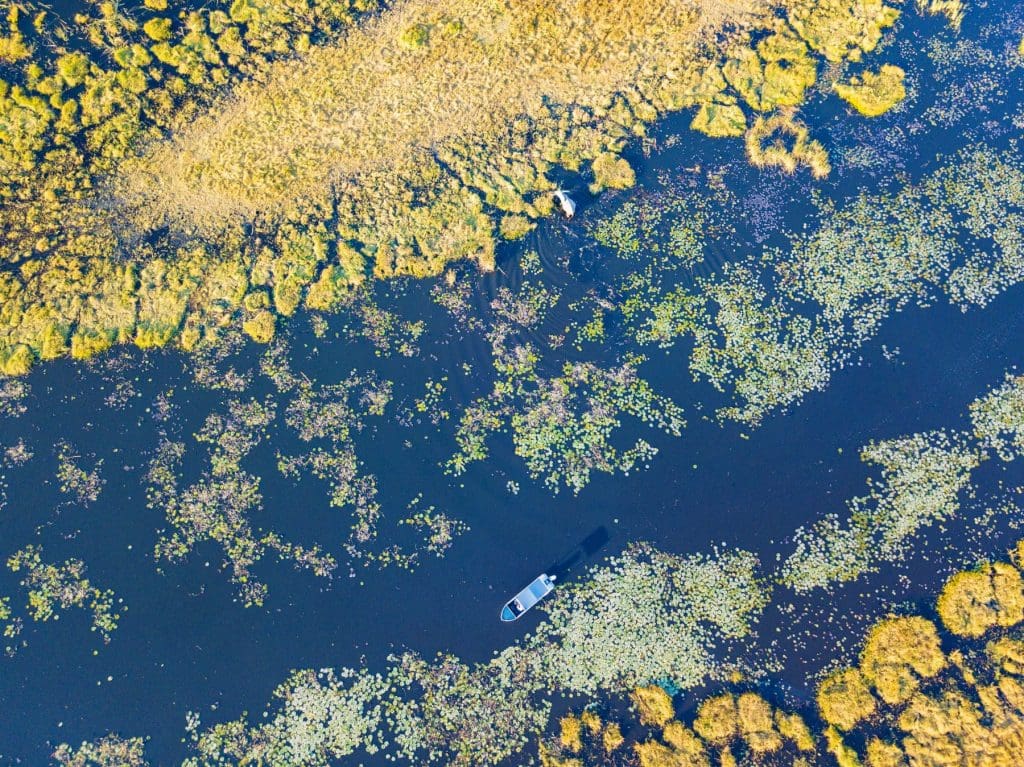
We encountered Beautiful Lady while we were staying at the luxurious Selinda Camp, which sits on the banks of the waterway the Selinda Spillway as it enters the Linyati River. But the leopardess was just the first of an array of fascinating animals and birds that the indefatigable Alex and Lizzie directed us towards in two drives that day.
Out in the 130,000-hectare private Selinda Reserve we watched groups of stately giraffes nibbling the tops of trees: we admired a wide variety of elegant antelopes – from the smaller impala and red lechwe, through the tsessebe and kudu and then up to the larger sable and waterbuck – who would stare at us curiously before leaping off into the bush: and at sunset we enjoyed a real treat, when an unusually large grouping of vultures in the trees provided the clue to locating a pack of laughing spotted hyenas settling down for supper over a much-chewed hippo carcass, one of them making remarkably short work of its tough, tarpaulin-like skin.
We warmed to the plucky, strutting little warthog – who would make a great children’s book character – with his tail held upright like a flag, also acting as antennae to warn his ilk of predators. And one of the most engaging sights was that of a delightful family of dwarf mongooses, frolicking on a termite mound before vanishing into its interior where they would speed along tunnels to their home.
The termite mounds, scattered all over Botswana’s bushes and plains, are truly one of the great wonders of nature. The millions of blind worker termites who build these extraordinary structures – often over six feet tall – are surely the insect world’s equivalent of the labourers and architects who constructed Egypt’s pyramids.
It is incredible to contemplate the speed at which these termites can raise tons of soil, particle by particle, while inside constructing the Queen’s royal cell and the brood galleries, food stores and fungus combs which make up their vast ‘city’. As we drove around our imaginations were fired by the different shapes and sizes, and the mounds seemed like sculptures in a museum, Queen Victoria here, a Roman senator there.
Selinda Camp
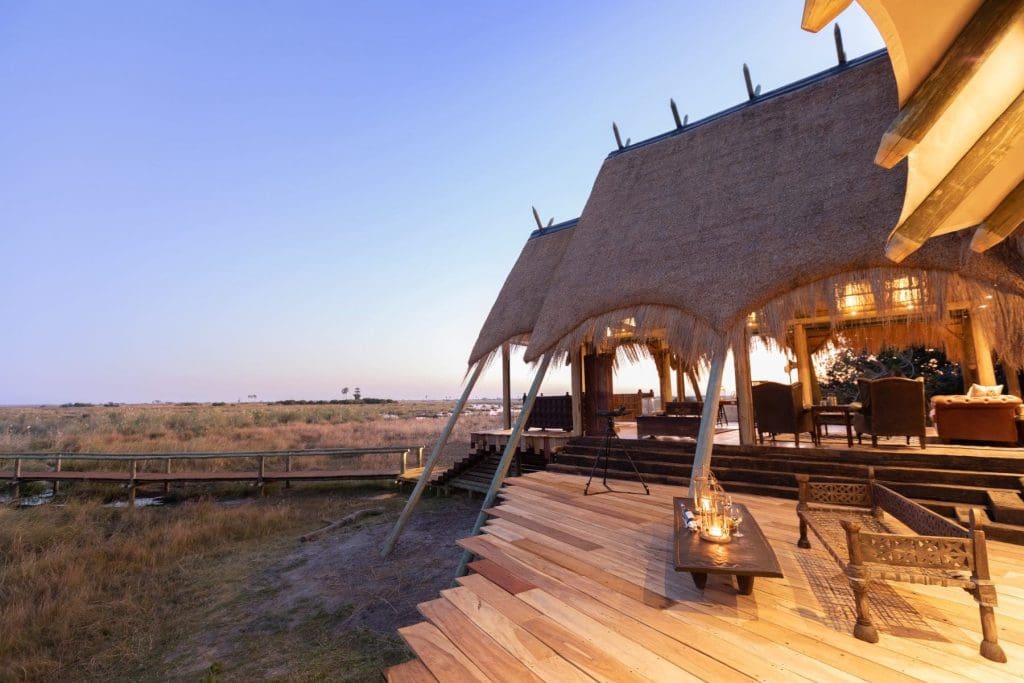
Back in Selinda camp, we had two close encounters with big beasts which our hosts shrugged off as everyday occurrences – but which for us were far from commonplace. On our first night, tired and hungry after our long flights, the ever-helpful staff set us up a table for dinner on the decking outside our tent. As we gazed into the inky blackness, a loud crunching noise managed to penetrate the cacophony of frog croaks and grunts that had, up until then, been the soundtrack to our meal.
Grabbing a torch and pointing it into the wide yonder, we were startled to light up, just a matter of yards away below our veranda, the most enormous hippopotamus, tucking into his supper of rich grass, thankfully totally oblivious to our presence.
Then the following day, as we left the camp for our morning drive, beast number two presented himself. Just yards from the camp’s front entrance, as we turned a corner of the drive, we were again startled to see off the road right next to us – and we could almost have leaned out and touched him – the most enormous bull elephant, snacking on the tasty leaves of a tall tree.
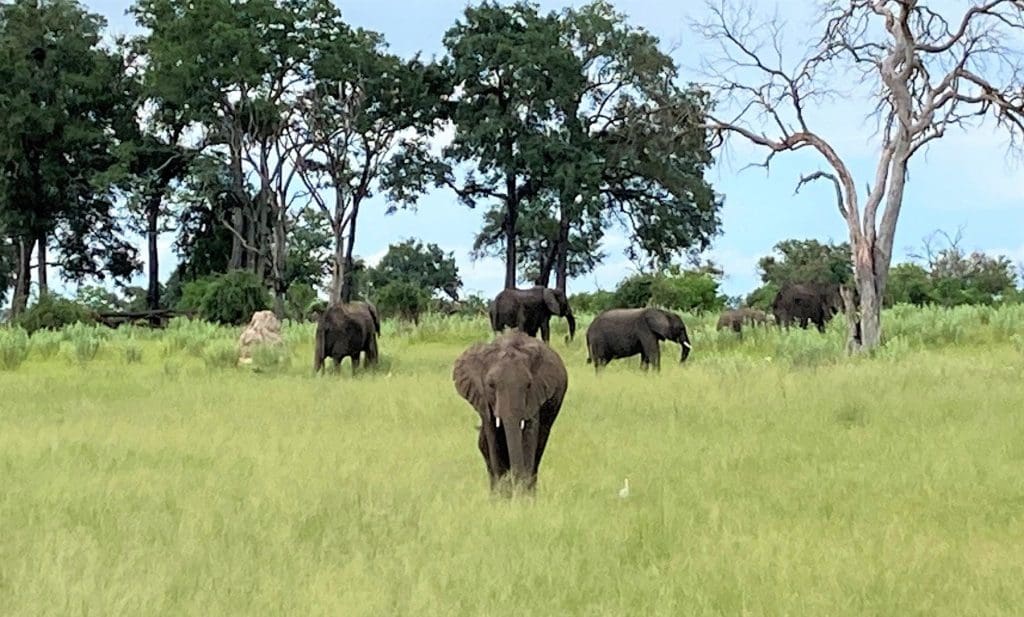
Alex told us it wasn’t unusual to see an elderly, lone male like this – probably around 40-50 years old (elephants can live to 70) – away from the herd, content with his own company. This one had clearly settled in for a ‘residency’ at Selinda, and while there was just a little concern about how much damage he might do around the fringes of the camp, his great hulking presence became just a feature of daily life.
Back in 1841, the great explorer and missionary Dr David Livingstone, with his retinue of porters and hunters, would have taken weeks to navigate the rough interior of Bechuanaland (as Botswana was then) when journeying from Gabane in the south to somewhere close to Selinda in the north.
Nowadays, thanks to the successful air charter company Mack Air, it’s less than an hour from the capital Maun to the airstrip close to the Selinda slipway. From the windows of our twelve-seater Cessna Caravan Ex we had our first, panoramic perspective of the vast Okavango Delta, scores of little waterholes scattered beneath us, and from time to time we could pick out a herd of wildebeest or antelope making their way to them.
Once landed, it was a 20-minute journey along the Selinda slipway to the camp. Time for our boat to steer well clear of the groups of hippos wallowing contentedly in the hour before sunset, and to observe a crocodile or two – thankfully not in the water, but basking in a sunny spot on the bank.
Botswana Safari Great Plains Hall of Fame
This was also the time when we began our quest to be admitted into the Great Plains Hall of Fame for our birdwatching activities. We are by no means professional ‘birders’, but armed with our Pocket Guide to the Birds of Southern Africa and – much more importantly – with Lizzy’s keen eye at our disposal, we started to tick off the 111 species (this area of well Botswana actually has well over 200) needed to achieve our goal, with some herons, egrets, ducks and teals to set us on our way.
On arrival at Selinda Camp, the staff lined up to give us a delightful, singing welcome before the current young, enthusiastic managers, Jamie and Ruby, took us on a guided tour. Remarkably, we discovered that Ruby’s family home back in England is just six miles away from where we live, and we have a number of mutual farming acquaintances. It is indeed a small world.
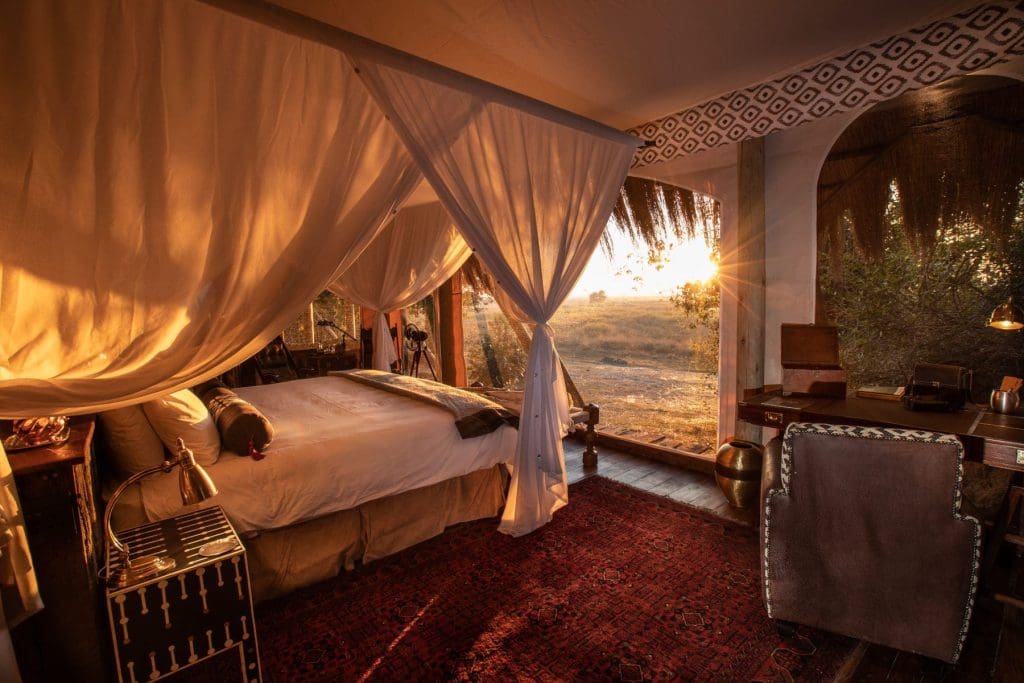
Selinda is a stylish, luxurious, shaded safari camp, run on sustainable (solar) energy, with superbly constructed high thatched roofs (built by local village craftsmen) covering the five suites and the expansive sitting, dining and library area. There is also a wine cellar, stocked mainly with South African wines recommended by friends of the Jouberts.
Dereck and Beverly – who want to reflect the historical spirit of exploration as well as highlighting the local cultures – themed Selinda to resemble the famous thatched village of Sangwali in neighbouring Namibia, where Dr Livingstone met Sebitwane, Chief of the great Makololo tribe, in an historic encounter in 1851. Beverly’s extraordinary photographs, particularly of leopards, adorn the walls of this camp and the others.
The description ‘canvas tent’ would not, of course, do our suite justice. On its polished wooden floors we had a supremely comfortable king-sized bed, with a ceiling fan to keep us cool and a mosquito net rolled out around it at night. Sliding wooden doors opened onto a spacious ensuite bathroom with double basins and a copper tub. Then there was an ample separate shower room, with easy-to-mix hot and cold water taps.
We had arrived on Valentine’s Night, and the staff put on the most thoughtful display for us, with a delightful heart shaped display of stones on the bed, a hot bubble bath prepared, and a bottle of champagne chilling.
Our enormous private veranda was equipped with a large plunge pool, together with exercise bike, chairs and sofa. In Selinda we were usually busy on drives, but in the downtime we had it was glorious to sit out and read, Michael Stanley’s thrilling Botswana-based crime novel A Deadly Covenant in hand, while gazing out into the bush for a glimpse of a big animal.
It was hard to tear ourselves away from Selinda, but we had two other Great Plains camps to explore, along with different terrain and different animals. After bidding farewell to the Selinda staff, Alex drove us to the airstrip just in time before the heavens opened (it was, after all the rainy season).
We had to hunker down for a couple of hours in the airstrip ‘lounge’, kept royally fed and watered, before the runway was safe enough for our Cessna to land, and take us on our way to our next stop, the Duba Explorers Camp on the edge of the Okavango Delta. Much more excitement awaited us.
Continue Eileen and Roger’s Botswana safari as they visit the Okavango Delta.
Botswana Safari
Click here for more information about Great Plains Conservation. Main image courtesy of Great Plains Conservation
